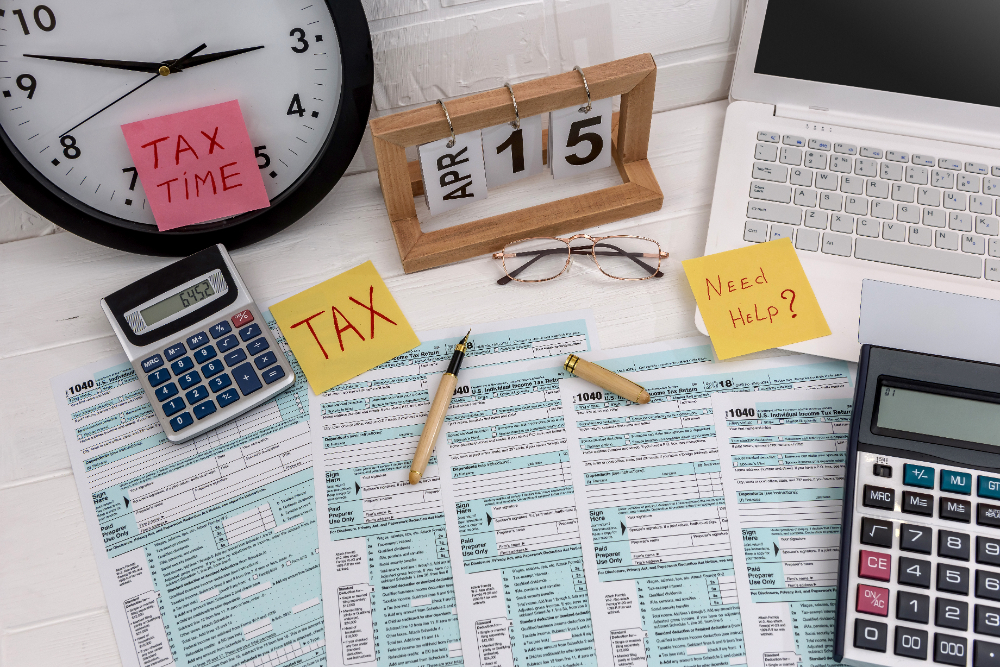Why Tax Planning Matters More Than Ever
Every year, it’s the same story — tax season sneaks up on you like that one nosy neighbor who just happens to show up when you’re mowing the lawn. Suddenly, it’s crunch time, and you’re scrambling to find receipts, tax slips, and that one form you swore you put in a “safe place.”
Sound familiar? You’re not alone. Taxes have a way of feeling complicated, confusing, and overwhelming — whether you’re dealing with W-2s in the U.S. or T4s in Canada. But here’s the good news: it doesn’t have to be that way.
With a little planning and some simple strategies, you can avoid last-minute panic, save money on your tax bill, and maybe even get a refund. The best part? It’s easier than you think. This guide will show you how to take control of tax season — before it takes control of you.
Why People Procrastinate on Taxes (And How to Avoid It This Year)
If you’ve ever found yourself cramming to finish your taxes at 11:59 pm on April 14th, you’re not alone. Most people procrastinate on taxes — not because they’re lazy — but because the whole process feels overwhelming and stressful.
Here’s why it happens and, more importantly, how to avoid it this year.
1️⃣ It Feels Complicated (So We Avoid It)
Forms, deductions, tax credits… it’s a lot to process. It feels like trying to solve a puzzle where half the pieces are missing. But here’s the truth: it only feels complicated because it’s unfamiliar.
How to Avoid It:
Break it down into smaller tasks. Instead of waiting until the last minute to do everything at once, dedicate 30 minutes a week to tackle one piece at a time. One week, gather your W-2s (U.S.) or T4s (Canada). The next, organize your receipts. By the time tax season rolls around, you’ll be ready.
Pro Tip: If this sounds like a lot to track, you’re not alone. Some people use simple tools to organize everything in one place — from tracking receipts to automatically categorizing expenses. It’s like having a personal assistant for tax season.
2️⃣ We Think We Have More Time Than We Do
“April is months away” turns into “Oh no, it’s April 1st.” It’s easy to feel like you have all the time in the world — until you don’t. In the U.S., the deadline is usually April 15th, while in Canada, it’s typically April 30th. But in both countries, those deadlines have a way of sneaking up on you.
How to Avoid It:
Set a personal deadline for yourself in February or March. When you file early, you avoid the last-minute rush, and if you’re owed a refund, you get it faster. Plus, if there’s an issue with your return, you’ll have time to fix it without the stress of a looming deadline.
Pro Tip: Treat tax season like a project with a due date earlier than the actual deadline. By aiming to finish in March, you’ll avoid the April panic — and maybe even get your refund faster.

3️⃣ We Don’t Know Where to Start (So We Do Nothing)
Let’s be honest — if you don’t know which forms you need or where to find them, it’s tempting to just put it off. But once you get organized, the process becomes way less stressful.
How to Avoid It:
Start with the “3 Document Rule.” No need to track down every single piece of paper right away — just start with these essentials:
- U.S.: Your W-2s (for employees) or 1099s (for freelancers/self-employed)
- Canada: Your T4s (for employees) or T4A/T5 slips (for contractors/self-employed)
- Your previous year’s tax return (this helps you copy over key info, like deductions from last year)
Once you have these, you’re halfway there. From there, you can track down any additional forms, like interest statements (U.S. 1099-INT or Canadian T5s) or mortgage interest statements.
Pro Tip: If you’re not sure which forms you need, check your email or online accounts for “Tax Documents Ready” emails from your employer, bank, or investment platforms. Most companies send them out automatically.
Simple Ways to Save Money on Taxes (That Most People Miss)
If you’re like most people, you want to know one thing: How can I pay less in taxes? The answer? Tax credits, deductions, and strategic planning. Here are some of the simplest ways to legally reduce your tax bill.
1️⃣ Don’t Miss Out on Tax Deductions
A deduction reduces your taxable income, which means you’re taxed on a smaller amount. The more deductions you have, the lower your overall tax bill.
Common Deductions You Might Be Missing:
- Home Office Deduction: If you work from home, you may be able to deduct a portion of your rent, utilities, and internet costs.
- Charitable Contributions: Even small donations to nonprofits can be deducted, as long as you have a receipt.
- Medical Expenses: If your out-of-pocket medical expenses are more than 7.5% of your income, you may be able to deduct them.
- Education Expenses: Tuition, student loan interest, and some certification fees are deductible.
2️⃣ Take Advantage of Tax Credits (They’re Better Than Deductions!)
Unlike deductions (which reduce your taxable income), tax credits are even better because they reduce your tax bill dollar-for-dollar. In simple terms, a $1,000 tax credit means you pay $1,000 less in taxes — and that’s a big win.
Here are some common tax credits you might be eligible for in both the U.S. and Canada:
For U.S. Taxpayers
- Child Tax Credit: If you have kids, you may qualify for this credit, and it’s one of the most valuable credits out there.
- Earned Income Tax Credit (EITC): If you have a moderate-to-low income, you might qualify for this credit — even if you don’t owe taxes.
- Energy Efficiency Tax Credits: If you made energy-efficient home improvements (like solar panels, windows, or insulation), you may qualify for a credit.
For Canadian Taxpayers
- Canada Child Benefit (CCB): Similar to the U.S. Child Tax Credit, this benefit provides payments to parents of children under 18.
- Canada Workers Benefit (CWB): This credit supports lower-income workers, similar to the Earned Income Tax Credit (EITC) in the U.S.
- Home Accessibility Tax Credit (HATC): If you’ve made renovations to make your home more accessible (like ramps or modified bathrooms), you may qualify for this tax credit.
- Energy Efficiency Rebate Programs: While not always direct tax credits, some provinces offer rebates for energy-efficient home upgrades like insulation, windows, and heat pumps.
Pro Tip: Tax credits vary depending on your location, income, and personal situation. If tracking them all feels overwhelming, some people use tools that automatically track tax credits for them, so they never miss an opportunity to save.
3️⃣ Contribute to Your Retirement Accounts
When you contribute to retirement savings, you’re not just planning for your future — you’re also reducing your tax bill today. Contributions to certain retirement accounts lower your taxable income, which means you could pay less in taxes this year.
Here’s how it works for both U.S. and Canadian taxpayers:
For U.S. Taxpayers
- 401(k) Contributions: If you contribute to a 401(k) through your employer, your contributions are made pre-tax, which means you lower your taxable income immediately.
- Traditional IRA Contributions: If you contribute to a Traditional IRA, you can deduct those contributions from your taxable income (as long as you meet the eligibility requirements). The good news? You can still make contributions for the previous tax year up until April 15th of the following year.
For Canadian Taxpayers
- Registered Retirement Savings Plan (RRSP) Contributions: Contributing to your RRSP is similar to the U.S. 401(k) system. Your contributions reduce your taxable income for the year, and you can keep growing your investments tax-free until withdrawal.
- Contribution Deadline: Canadians have until March 1st of the following year to contribute to their RRSPs for the previous tax year. This gives you extra time to boost your contributions and reduce your taxable income.
Pro Tip: Both U.S. and Canadian taxpayers can take advantage of these contributions even after the tax year ends. If you missed your chance during the year, you can still contribute before the April 15th (U.S.) or March 1st (Canada) deadline to reduce last year’s taxes.
Tax Planning Strategies for Self-Employed & Freelancers
If you’re self-employed, taxes hit a little differently. You’re responsible for everything — from estimating quarterly payments to tracking every receipt. But with the right strategy, you can save big on taxes.
1️⃣ Quarterly Payments Are a Must
As a freelancer or self-employed worker, you don’t get taxes taken out of your paycheck like a regular employee. That means you need to send payments to the IRS every quarter.
How to Do It:
Set aside 30% of every payment you receive and make estimated payments four times a year. This way, you won’t be hit with a giant tax bill in April.
2️⃣ Track Your Deductions (Because You Can Write Off So Much!)
When you’re self-employed, a lot of your business expenses are tax-deductible. That means you can reduce your taxable income and pay less in taxes.
Deductions You Should Track:
- Business equipment (laptops, phones, cameras)
- Home office expenses (a portion of rent, internet, utilities)
- Business-related travel, meals, and subscriptions
Pro Tip: Tracking these expenses can feel like a lot. Some people use tools to track expenses, categorize deductions, and even scan receipts.
Want an Easier Way to Stay Ahead This Year?
Tracking income, expenses, and deductions all year long isn’t exactly fun. But it’s way easier when you don’t have to do it manually.
That’s why some people use simple tools that track everything in one place. These tools organize your receipts, calculate your deductions, and send reminders before tax deadlines — so you never have to stress about last-minute panic.
Pro Tip: Look for tools that let you upload receipts, track expenses automatically, and keep everything stored in one place. If you would like our assistance in this, we would be happy to discuss these tools with you. Click here to book a time to talk with us.
Don’t Let Tax Season Sneak Up on You This Year
This year can be different. You don’t have to be stressed, scrambling, or searching for random receipts in April.
Here’s the simple plan:
- Start early (not in April).
- Use tools to track expenses and organize everything.
- Take advantage of credits and deductions.
Tax planning isn’t about perfection — it’s about being prepared. And if you’ve read this far, you’re already on your way. Schedule a time to talk with our team, and we’ll help you take control of your taxes, save yourself from stress, and keep more of your money where it belongs — with you.


